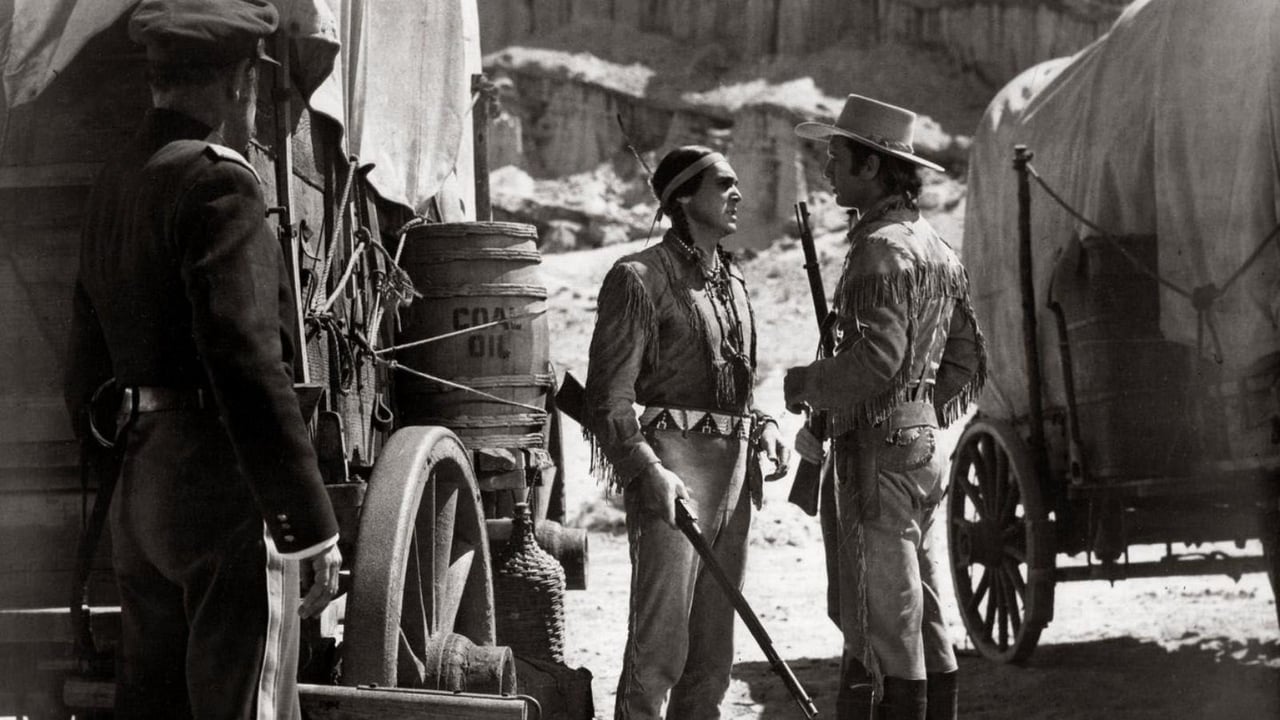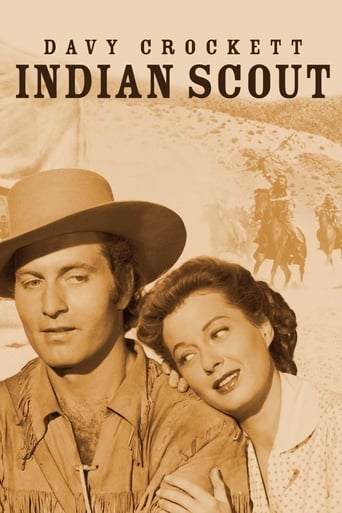


SYNOPSIS: The title is a bit of a "have", as this Davy Crockett is not the famous king of the wild frontier, but a fictitious military scout who happens to be named after that "uncle". COMMENT: This picture utilizes so much footage from Kit Carson (1941) that Mescall is credited as co-photographer (he retired in 1945). However, it's not only well matched by Diskant but smoothly integrated by the editors. And it's such superbly spectacular footage that we don't at all mind seeing it again in these new surroundings. In fact Mescall's footage actually looks more impressive here than it did in Kit Carson where it was undermined by both poor acting and indifferent direction - plus the offset of a long and tedious anti-climax. Arthur Rosson directed the Mescall scenes. The rest of Davy Crockett is handled by Lew Landers in a what can only be described by his humble standards as a fairly lively fashion. The principals play competently enough, and the pacing appears reasonably fast. True, the dialogue sounds cliched, whilst the characters present themselves as little more than the usual stereotypes; but, all told - and thanks chiefly to the attractive Diskant/Mescall cinematography - this Davy Crockett comes across as likable enough entertainment for undemanding action fans.
... View MoreAH YES, HOW well we remember this movie! We always associate it with the Thanksgiving Holidsay; for It is a true Turkey if there ever was one! NOW, IT'S NOT that it is not the Walt Disney version which it isn't. Or it has no Fess Parker, which it doesn't, no Georgie Russell, no Tennesee backwoods, no Chief Red Stick, Mike Fink, Riverboats, no "grinnin'down bears", no U.S. Comngress and not even a mention of the Alamo. These items are irritating, but only in a minor sense.WHAT REALLY BOTHERS us is that it seems to be a sort of Western Movie anachronism. The period portrayed looks more like the post Civil War era than the 1820's and '30's; which would be about the right time-line. After all, Davy Crocket's life spanned 1786-1836.WHEN WE SCREENED this movie, it was on the rebound. Originally released in 1950, it was hurried back into a re-release in 1955. It was a case of "making hay while the sun shines", for the Disney DAVY CROCKETT boom was in full flower. Why wouldn't the producers get out there again? The title would get the audience and the kids wouldn't know the difference; at least until It was too late. THE LEAD WAS tall, athletic and handsome, George Montgomery. He was a former Heavyweight Prize Fighter, World War II Army Air Corps veteran and highly respected movie star. In addition to many other higher class Westerns, he had also portrayed Raymond Chandler's Phillip Marlowe in THE BRASHER DOUBLOON (20th Century-Fox, 1947).AMONG OTHER SHORTCOMINGS, it was in glorious Black & Wjhite, its costuming had the "Dime Store Cowboy" look, the exteriors looked a lot like the famous Ray Corrigan Ranch*,nobody sounded East Tenneesee and there was no attempt authentically recreate the real period.WE SEEM TO recall some other rather glaring errors in this chronological thing. It seems that the "cowboys" used more modern weapons. Rather than black powder loading flintlocks, we recall six guns and carbines.EVEN IN NAMING the characters there was no logic used. Noah Berry, Jr. was called "Tex"; which was a very unlikely moniker then. This was before the Alamo, right? WE WENT TO see this movie as part of my birthday present. I could take a friend, so we asked neighbor kid, David Brommer, to accompany us. It was my choice to decide between which of the two local theatres to attend. This DAVY CROCKETT, Indian FIGHTER was at the Ogden, 63rd Street & Ashland. The Highway at 63rd & Western had ABBOTT & COSTELLO MEET THE KEYSTONE KOPS. Although my pal, David, lobbied for ABBOTT & COSTELLO.AGFTER ALL THESE years, I admit it. I was wrong. I'm sorry Sorry, David. Next time you choose, okay?
... View MoreRugged, clean-cut, square-jawed George Montgomery plays the heroic title character in this atmospheric, large-scale, but low-budget wagon train/cavalry versus Indians western. "Davy Crockett, Indian Scout" generates a modicum of suspense in its mystery about a treacherous informant within the settlers' camp. This scoundrel keeps the Indians abreast of the changing route of the wagon train. Everything begins with an Indian attack on a wagon train heading for California in 1848, and the U.S. Army amasses evidence that concludes that a spy lies at the bottom of this treachery. The military convenes a hearing about the matter. White settler Mr. Sims (Erik Rolf of "U-Boat Prisoner") insists that their Cherokee scout Red Hawk (Philip Reed of "Unknown Island") is the guilty party. Red Hawk's longtime friend, Davy Crockett (George Montgomery of "Pawnee"), refuses to stand by and let Simms tar and feather Red Hawk with his groundless accusations based purely on racism. Davy reminds them that everything turned sour the moment they entered Kiowa country. At that moment, this western shifts into flashback mode. Red Hawk and he ride away to pow-wow with Kiowa chief Sleeping Fox (Chief Thundercloud of "The Searchers"), but the intractable Fox demands that Davy turn the wagon train around and leave the territory. Davy explains that he cannot accommodate Sleeping Fox, so the Kiowas try without success to kill Red Hawk and Davy. Our heroes make it back to the wagon train by the skin of their teeth. Later,things begin to boil with the arrival of a pretty white schoolmarm, Francis Oatman (Ellen Drew of "Stars in My Crown"), and her deaf-mute driver Ben (Paul Guilfoyle of "The North Star")who looks mighty suspicious. Davy rides out and rescues Oatman and Ben from a war party of Kiowas. Naturally, Davy becomes infatuated with the comely Miss Oatman. This flashback concludes with the introduction of the schoolmarm and Davy's romantic ambitions. The film reverts to the present just long enough for Red Hawk to refute Sims' next accusation about his absence from camp before the Indian attack. Later, in town, Davy sees Ben and believes that the deaf mute was talking with an Indian. Later, Davy tries to expose Ben's masquerade by firing his six-gun behind him in camp without warning. What Davy doesn't know is that Ben knew about Davy's scheme. He caught a glimpse of Davy fidgeting with his gun in a mirror so that he was prepared not to flinch at the sound of the thunderous gunshot."Tailspin Tommy" director Lew Landers directs this sprawling black & white western with flair and efficiency. Although he stages several scenes on obvious studio sets as a cost-cutting measure, he doesn't shrink from depicting the big action scenes in the great outdoors during the Indian rampage sequences. These scenes bolster an otherwise pallid western and makes it worth watching, especially if you enjoy horse operas. You can tell from the arid settings that these large-scale scenes were filmed out in the desert far away from a sound stage. Furthermore, the film benefits from the cat and mouse games that the Indians and the settlers indulge in when they have to decide which route to the fort is quicker or safest. The resolution to the mystery is well-handled, though the happy ending outcome is perhaps a mite far-fetched. Incidentally, Montgomery's Davyin the film--is a distant relative from the real Davy. As the civilian tracker for the wagon train, amiable Noah Beery, Jr., who played in the James Garner television series "The Rockford Files," contributes another solid supporting performance. Surprisingly, the hero doesn't get the gal, but the happy ending has the true-hearted lovers getting hitched. it's still a happy ending. All in all, "Davy Crocket, Indian Scout" doesn't hold a candle to anything that John Ford directed, but neither is this black & white United Artists release a bad oater.
... View MoreThis run-of-the-mill western is mostly made up of stock footage from Edward Small's earlier frontier epic, "Kit Carson" (1940). They've dressed Montgomery in the same wardrobe as Jon Hall wore in the earlier film, so they even have used some of the non-action scenes stolen from "Carson".If that wasn't bad enough, the plot is tired, the acting poor, and if their was any director on the set, he must've stepped out for a short beer during the shoot. If you ever were expecting Disney's version of Crockett, or Fess Parker, forget it! They threw this mediocre little western BACK on the theatre screen in 1955, at the height of the Crockett hysteria, for a fast buck. Those of us that paid that buck, left the theater in tears! A worthwhile experience, though-it taught us not to trust Hollywood!
... View More